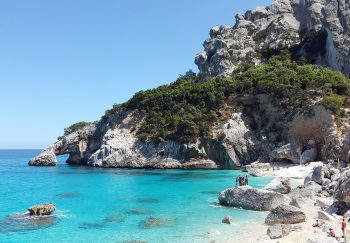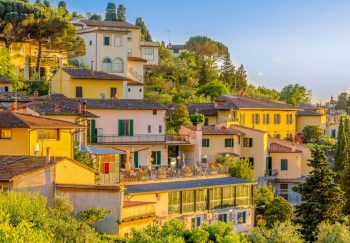Naples is one of the most difficult cities to like in Italy, I would venture to say. It can be quite abrasive and although I love it (and you should, too), I understand why people need a break from all the chaos and confusion of . Day trips are a great option.
Many of Italy’s most famous attractions and destinations are also available as day trips from Naples. So whether you’re just using Naples to explore the area, or you want to spice up your Naples vacation with some exciting excursions, you won’t be disappointed.
Below is a list of options. They are sorted by how long it takes to get there or back. I started with the nearest places. Public transportation is my preferred method of getting there. However, if you are interested in renting a car, that option is also available. (I would not recommend driving in Naples unless a veteran. This is not a complete list of day trips from Naples. It’s just a place to start your brainstorming.
Guided Tours in & from Naples
These places can all be done as day trips. But if you prefer to leave the planning to others, here are some tours from and to Naples.
-
Context Travel Walking Tours to Naples -
Viator Tours to Naples -
Select Italy Tours from Naples
-
Walks of Italy Tours
You might also consider a Neapolitan native tour guide. She is so passionate about Naples that she would make any person fall in love with it. Tell Marina that I sent you.
Fast Day Trips From Naples: In Transit in 2 Hours or Less
- Pompeii I don’t have to convince you about the idea of going to Pompeii. This world-famous (and enormous) excavation site is located in the shadows of the volcano that buried them. It is only 45 minutes away from Naples by the Circumvesuviana train.
- Herculaneum– This is where I need to sell a few things. Most people have heard of Pompeii. But not as many people have visited Herculaneum (Ercolano) in Italian. It was the beach resort to Pompeii’s main city. It was also buried in the year 79 C.E. eruption of Mt. Vesuvius. Although the site excavated is smaller than Pompeii, it is better preserved and less crowded. You can combine a Pompeii trip with the Circumvesuviana train to get there in 20 minutes.
- Caserta The palace of the same title, which is basically Italy’s Versailles, is located in Caserta. The Palace of Caserta, which was built in 18th century (yes, Versailles was the inspiration), has large gardens and water features. By train, the city is approximately 40 minutes away from Naples.
- Bay of Naples Islands It takes only a ferry ride for you to trade Naples’ grit and get an island’s sparkle. Pretty Capri is 40 minutes away by boat and offers the Blue Grotto as well as ancient Roman ruins and chic shopping. The setting for “Il Postino” was Little Procida, a pastel-colored island 56 minutes away by boat. There are worse fates.
- Capua– Just outside Caserta lies the excavation site Santa Maria Capua Vetere, which is located near the modern city Capua. It is home to remnants of an ancient Roman amphitheater that was once the second-largest in Italy. The Mithraeum is a temple dedicated and frescoed to Mithras. It can be requested by anyone who calls. Santa Maria Capua Vetere can be reached by train in 53 minutes. You can also visit the Mithraeum via side trip from Caserta, which connects both attractions.
- Salerno is the next stop on the high-speed rail network. It takes approximately 40 minutes to reach this point. The cathedral’s crypt, which dates back to 11th-century, contains the tomb of Saint Matthew. It is a perfect spot for a stroll along the coast.
Medium Day Trips From Naples: 2 – 4 Hours in Transit
- Amalfi coast – The towns of the are among the most visited places in Italy. If you aren’t sure why, try an internet image search for “Positano”. I will get back to you. There is regular bus service to the Amalfi Coast, although there are no train stations. You can take the Circumvesuviana train to Naples from Sorrento, which takes about an hour and ten mins. Then you can catch a bus to Positano or Amalfi in 50 minutes, one hour 40 minutes, or any other beautiful towns.
- Sorrento Although Sorrento technically isn’t part of the Amalfi coast (it’s actually on the Sorrentine peninsula, which is kind of between Naples & the Amalfi coast), it’s very similar in many aspects. It’s also easy to get there from Naples. The old Circumvesuviana train takes about an hour and ten minutes to make the journey, while the new Campania Express, which is only available in high season, connects the two cities in approximately 50 minutes. There are also a variety of boats that can cross the river in around 40 minutes.
- Rome– The big city of Rome can be reached in just one hour and ten minutes by high-speed trains from Italy. Although it’s impossible for Rome to be covered in one day, you can book a tour that covers the highlights of Rome in a long day. The Italian capital will make you tired but also excited to return to Naples.
- Paestum– There are many ancient Roman ruins around Naples. However, there are also some outstanding ancient Greek ruins close by. Paestum, which is located about an hour and fifteen minutes from Naples by train has some of the most well-preserved Greek remains on the entire island. There are a few temples to be seen, as well as an amphitheater and tombs with frescoed and painted tombstones.
- Bay of Naples Islands I have mentioned other islands off the coast of Naples, but Ischia, the largest island, is a bit more difficult to reach so it’s moved to this section. You can reach Ischia in just one hour and twenty minutes from Naples. Here you will find beautiful villas, gardens, beaches, as well as the Aragonese Castle (5th century).
- Phlegraean Fields This area is just west of Naples and offers some spectacular sightseeing. You will find ancient Roman and Greek ruins and lakes, as well as hissing volcanic craters and underwater ruins. There is also a lot of mythology to be learned about. The Phlegraean Fields, or Campi Flegrei, include the following towns: Baiae (Cuma), Pozzuoli, Solfatara, and Pozzuoli. You can take a complete tour with a guide, which will take most of the day. However, you can also go to individual sites on your own by bus or metro train. Baiae, for example, is approximately 30 minutes by metro from Naples. Pozzuoli is just 20 minutes away by Metro. Cuma is reached by bus or metro to Pozzuoli and another bus to Cumae.
- Mount Vesuvius You can view the volcano that destroyed Pompeii, Herculaneum and other sites from almost any location in Naples. But you can also see it up close. You can take the Circumvesuviana train from the Ercolano to the Pompei stop and then hop on one of the shuttle buses which picks up and drops off just outside the stations. Although the Ercolano stop may be closer, some believe the Pompei stop has the best and most reliable buses. It takes approximately 2-3 hours to complete a round trip bus tour.
- Formia, Gaeta, & Sperlonga – For a beachy day trip in another region that’s got both ancient and more modern history, consider the Formia-Gaeta-Sperlonga loop. Formia lies on the famed Appian Way. It’s also where Cicero, the Roman philosopher, is buried. Gaeta is home of many interesting churches and castles. A villa that was built in the 1st century C.E. can be viewed at Sperlonga. Roman Emperor Tiberius. The beaches of all three towns are also available. Formia, Gaeta, and other nearby communities are linked to World War II history. It takes approximately 50 minutes to get from Naples to Formia. The bus connects to Gaeta within 15 minutes and Sperlonga in thirty minutes.
For longer day trips from Naples, 4+ hours in transit
- Florence and Florence are probably already on your . But, just in case it isn’t, you should know that the high-speed trains of Italy make the trip from Naples to Rome in approximately two hours 45 minutes. It’s quite a long day. But if you plan well, you can make it a memorable one.
- Tivoli – The UNESCO World Heritage Sites of Tivoli are a much easier day trip from Rome. However, it is worth considering at 2 hours 45 minutes train ride from Naples. The 2nd century C.E. excavation can be visited. You can also visit Hadrian’s Villa and the 16th-century Villa d’Este, with its lush gardens and water features.


